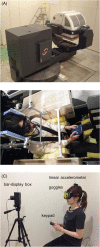Effect of head roll-tilt on the subjective visual vertical in healthy participants: Towards better clinical measurement of gravity perception
- PMID: 33134543
- PMCID: PMC7585259
- DOI: 10.1002/lio2.461
Effect of head roll-tilt on the subjective visual vertical in healthy participants: Towards better clinical measurement of gravity perception
Abstract
Objective: Gravity perception is an essential function for spatial orientation and postural stability; however, its assessment is not easy. We evaluated the head-tilt perception gain (HTPG, that is, mean perceptual gain [perceived/actual tilt angle] during left or right head roll-tilt conditions) and head-upright subjective visual vertical (SVV) using a simple method developed by us to investigate the characteristics of gravity perception in healthy participants.
Methods: We measured the SVV and head roll-tilt angle during head roll-tilt within ±30° of vertical in the sitting and standing positions while the participant maintained an upright trunk (sitting, 434 participants; standing, 263 participants). We evaluated the head-upright SVV, HTPG, and laterality of the HTPG.
Results: We determined the reference ranges of the absolute head-upright SVV (<2.5°), HTPG (0.80-1.25), and HTPG laterality (<10%) for the sitting position. The head-upright SVV and HTPG laterality were not influenced by sex or age. However, the HTPG was significantly greater in women than in men and in middle-aged (30-64 years) and elderly (65-88 years) participants than in young participants (18-29 years). The HTPG, but not the head-upright SVV or HTPG laterality, was significantly higher in the standing vs sitting position.
Conclusion: The HTPG is a novel parameter of gravity perception involving functions of the peripheral otolith and neck somatosensory systems to the central nervous system. The HTPG in healthy participants is influenced by age and sex in the sitting position and immediately increases after standing to reinforce the righting reflex for unstable posture, which was not seen in the head-upright SVV, previously considered the only parameter.
Level of evidence: 4.
Keywords: gravity perception; head‐tilt perception gain; healthy participants; subjective visual vertical.
© 2020 The Authors. Laryngoscope Investigative Otolaryngology published by Wiley Periodicals LLC on behalf of The Triological Society.
Conflict of interest statement
The authors declare no conflict interests.
Figures




Similar articles
-
Gravity perception disturbance in patients with unilateral Meniere disease.Laryngoscope Investig Otolaryngol. 2023 Jan 16;8(1):212-219. doi: 10.1002/lio2.1011. eCollection 2023 Feb. Laryngoscope Investig Otolaryngol. 2023. PMID: 36846418 Free PMC article.
-
[Development of a Clinical Examination to Evaluate Gravity Perception during Static Head Roll Tilt].Nihon Jibiinkoka Gakkai Kaiho. 2016 Sep;119(9):1201-9. Nihon Jibiinkoka Gakkai Kaiho. 2016. PMID: 30035900 Japanese.
-
Head Roll-Tilt Subjective Visual Vertical Test in the Diagnosis of Persistent Postural-Perceptual Dizziness.Otol Neurotol. 2021 Dec 1;42(10):e1618-e1624. doi: 10.1097/MAO.0000000000003340. Otol Neurotol. 2021. PMID: 34538854 Free PMC article.
-
The interaction of otolith and proprioceptive information in the perception of verticality. The effects of labyrinthine and CNS disease.Ann N Y Acad Sci. 1999 May 28;871:324-33. doi: 10.1111/j.1749-6632.1999.tb09195.x. Ann N Y Acad Sci. 1999. PMID: 10372082 Review.
-
Perception of Verticality and Vestibular Disorders of Balance and Falls.Front Neurol. 2019 Apr 3;10:172. doi: 10.3389/fneur.2019.00172. eCollection 2019. Front Neurol. 2019. PMID: 31001184 Free PMC article. Review.
Cited by
-
Gravity perception disturbance in patients with unilateral Meniere disease.Laryngoscope Investig Otolaryngol. 2023 Jan 16;8(1):212-219. doi: 10.1002/lio2.1011. eCollection 2023 Feb. Laryngoscope Investig Otolaryngol. 2023. PMID: 36846418 Free PMC article.
-
Frailty of the.J Int Adv Otol. 2024 Jan;20(1):76-80. doi: 10.5152/iao.2024.231181. J Int Adv Otol. 2024. PMID: 38454293 Free PMC article.
-
Long-term outcomes of pharmacotherapy in patients with persistent postural-perceptual dizziness.Front Neurol. 2025 Mar 19;16:1566898. doi: 10.3389/fneur.2025.1566898. eCollection 2025. Front Neurol. 2025. PMID: 40177407 Free PMC article.
-
Bilateral Asymmetry in Ocular Counter-Rolling Reflex Is Associated With Individual Motion Sickness Susceptibility.Front Neurol. 2021 Nov 19;12:759764. doi: 10.3389/fneur.2021.759764. eCollection 2021. Front Neurol. 2021. PMID: 34867744 Free PMC article.
References
LinkOut - more resources
Full Text Sources
Research Materials
